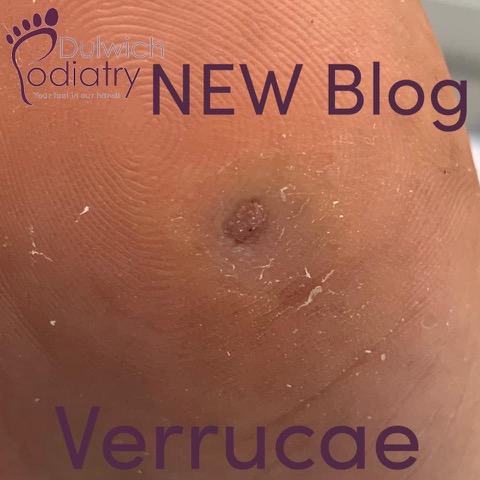Verrucae

This month’s blog features the bane of swimmers, gym-goers and parents of small children everywhere – the ever-persistent verruca.
Verrucae are caused by the same virus as warts, the human papillomavirus (HPV), of which there are numerous strains.
It is possible to cross infect other parts of the body from contact with a wart or verruca, so one of the very first things we recommend if you suspect you might have a wart or verruca is to not pick at it or file it.
This image of one of our podiatrists ‘filing’ a biro ‘verruca’ on the back of her gloved hand illustrates the potential spread of infection.
As well as the feet, a trained podiatrist is insured to treat warts on other parts of the body barring the torso, face or genitals.
Verrucae are harmless and usually painless but they are highly contagious, particularly in warm, moist shared environments such as swimming pools, dressing rooms and bathrooms. The virus requires direct contact with the skin and most often gains entry into the skin via abrasions and fissures on the foot, which also make walking barefoot on rough surfaces an increased infection risk.
Most verrucae will resolve on their own over time, particularly in children, but treatments are available to speed up the process if the verrucae are painful or causing distress.
There are a number of different treatments offered at Dulwich Podiatry, including:
- Salicylic acid
- Cryotherapy
- Verruca Needling
- Low level laser therapy
- Verruca Pen ®
IS it a verruca?
It cannot always be easy to tell a corn and a verruca apart. Both require a very different treatment regime it is highly recommended that you visit your podiatrist at earliest opportunity in order to have an accurate diagnosis and begin an effective and relevant treatment plan.
Some of the ways of telling a corn and a verruca apart is that a verruca will sometimes, but not always, have tell-tale block dots in it. A verruca will also feel uncomfortable when squeezed from the sides (sometimes described as feeling like there is something sharp inside it) though often not when pressed directly or when walked upon, whereas a corn is more likely to be painful when weight is applied directly to the top of it. A corn may also be indicated by its location since it is caused by pressure from shoes or walking.
Verrucae can be very persistent and even with treatment can take a great deal of time and dedication to make go away. Healing time can be radically impacted by the state of the patient’s general health and immunity.
If you find an abnormality on the foot which you suspect might be a verruca:
DO NOT
- touch/pick at it. Verrucae are highly contagious and can be transferred to other parts of the body by contact
- file it. This may break the skin and spread infection.
- walk barefoot on shared public floors. This may spread the virus to others doing the same.
- panic. Verrucae are harmless and usually painless.
DO
- Book an appointment with your podiatrist to ascertain what it is and how it should be treated.
- Follow the treatment plan diligently. Verrucae are very persistent and the success rate of effective treatment rapidly plummets if appointments become irregular and/or homecare is neglected.
- Invest in a pair of flip flops for shared walking surfaces – particularly gyms and pools where the virus runs rife.
To find out more about the various treatment options offered by Dulwich Podiatry, contact us on 020 8693 6000.



